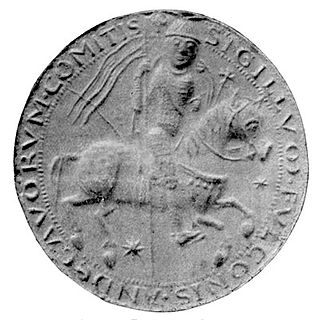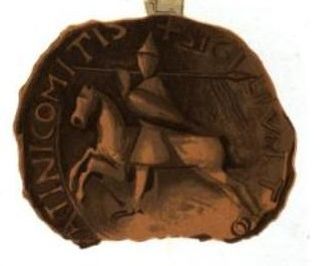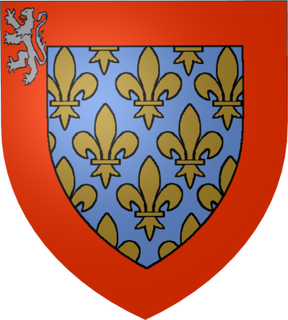Related Research Articles

Anjou was a French province straddling the lower Loire River. Its capital was Angers and it was roughly coextensive with the diocese of Angers. Anjou was bordered by Brittany to the west, Maine to the north, Touraine to the east and Poitou to the south. The adjectival form is Angevin, and inhabitants of Anjou are known as Angevins. During the Middle Ages, the County of Anjou, ruled by the Counts of Anjou, was a prominent fief of the French crown.
Charles III, called the Simple or the Straightforward, was the king of West Francia from 898 until 922 and the king of Lotharingia from 911 until 919–23. He was a member of the Carolingian dynasty.

The Château de Langeais is a 15th century Flamboyant Gothic castle in Indre-et-Loire, France, built on a promontory created by the small valley of the Roumer River at the opening to the Loire Valley. Founded in 992 by Fulk Nerra, Count of Anjou, the castle was soon attacked by Odo I, Count of Blois. After the unsuccessful attack, the now-ruined stone keep was built; it is one of the earliest datable stone examples of a keep. Between 994 and 996 the castle was besieged unsuccessfully twice more. During the conflict between the counts of Anjou and Blois, the castle changed hands several times, and in 1038 Fulk captured the castle again.
Robert I, was the elected King of West Francia from 922 to 923. Before his election to the throne he was Count of Poitiers, Count of Paris and Marquis of Neustria and Orléans. He succeeded the overthrown Carolingian king Charles the Simple, who in 898 had succeeded Robert's brother, king Odo.

Fulk, also known as Fulk the Younger, was the count of Anjou from 1109 to 1129 and the king of Jerusalem from 1131 to his death. During his reign, the Kingdom of Jerusalem reached its largest territorial extent.

Maine[mɛːn] is one of the traditional provinces of France. It corresponds to the former County of Maine, whose capital was also the city of Le Mans. The area, now divided into the departments of Sarthe and Mayenne, counts about 857,000 inhabitants.

Theobald the Great (1090–1152) was count of Blois and of Chartres as Theobald IV from 1102 and was count of Champagne and of Brie as Theobald II from 1125. Theobald held Auxerre, Maligny, Ervy, Troyes, and Châteauvillain as fiefs from Duke Odo II of Burgundy.
William the Great was duke of Aquitaine and count of Poitou from 990 until his death. Upon the death of the emperor Henry II, he was offered the kingdom of Italy but declined to contest the title against Conrad II.
Alan III of Rennes was Count of Rennes and duke of Brittany, by right of succession from 1008 to his death.

Fulk III, the Black was an early Count of Anjou celebrated as one of the first great builders of medieval castles. It is estimated Fulk constructed approximately 100 castles, along with abbeys throughout the Loire Valley in what is now France. He fought successive wars with neighbors in Brittany, Blois, Poitou and Aquitaine and made four pilgrimages to Jerusalem during the course of his life. He had two wives and three children.
Geoffrey II, called Martel, was Count of Anjou from 1040 to 1060 and Count of Vendôme from 1032 to 1056. He was the son of Fulk the Black. He was bellicose and fought against William VII, Duke of Aquitaine, Theobald I, Count of Blois, and William, Duke of Normandy. During his twenty-year reign he especially had to face the ambitions of the Bishop of Le Mans, Gervais de Château-du-Loir, but he was able to maintain his authority over the County of Maine. Even before the death of his father in 1040, he had extended his power up to the Saintonge, where he founded the Abbey aux Dames. Geoffrey Martel and his wife Agnes also founded the Abbaye de la Trinité at Vendôme. The first mention of Geoffrey in the Gesta Normannorum Ducum reads: "Geoffrey, count of the Angevins, nicknamed Martel, a treacherous man in every respect, frequently inflicted assaults and intolerable pressure on his neighbors."
Conan I nicknamed Le Tort was the Duke of Brittany from 990 to his death.
Theobald III of Blois (1012–1089) was count of Blois, Meaux and Troyes. He was son of Odo II, Count of Blois and Ermengarde of Auvergne.
Odo II was the count of Blois, Chartres, Châteaudun, Beauvais and Tours from 1004 and count of Troyes and Meaux from 1022. He twice tried to make himself a king: first in Italy after 1024 and then in Burgundy after 1032.

Odo I, Count of Blois, Chartres, Reims, Provins, Châteaudun, and Omois, was the son of Theobald I of Blois and Luitgard, daughter of Herbert II of Vermandois. He received the title of count palatine, which was traditional in his family, from King Lothair of West Francia.

Herbert II, Count of Vermandois, Count of Meaux, and Count of Soissons. He was the first to exercise power over the territory that became the province of Champagne.
Theobald I (913–975), called the Trickster, was the first count of Blois, Chartres, and Châteaudun as well as count of Tours.
Herbert I, called Wakedog, was the count of Maine from 1017 until his death. He had a turbulent career with an early victory that may have contributed to his later decline.
Ermengarde-Gerberga of Anjou, also called Ermengarde of Anjou, was the Countess of Rennes, Regent of Brittany (992–994) and also Countess of Angoulême.

Hugh III became Count of Maine on his father Hugh II's death, c. 991.
References
- ↑ Kim Hjardar & Vegard Vike. Vikings at War. Casemate Publishers & Book Distributors, LLC, 2016. p 334
- ↑ Barton 2004, p. 44.